06 March 2023
Threat landscape for industrial automation systems. Statistics for H2 2022
2022 in numbers
| Parameter | H1 2022 | H2 2022 | 2022 |
| Percentage of attacked ICS computers globally | 31.8% | 34.3% | 40.6% |
| Main threat sources | |||
| Internet | 16.5% | 19.9% | 24.0% |
| Email clients | 7.0% | 6.4% | 7.9% |
| Removable devices | 3.5% | 3.8% | 5.2% |
| Network folders | 0.6% | 0.6% | 0.8% |
| Percentage of ICS computers on which malicious objects from different categories were blocked | |||
| Malicious scripts and phishing pages (JS and HTML) | 12.9% | 13.5% | 17.3% |
| Denylisted internet resources | 9.5% | 10.1% | 13.2% |
| Spy Trojans, backdoors and keyloggers | 8.6% | 7.1% | 9.2% |
| Malicious documents (MSOffice+PDF) | 5.5% | 4.5% | 6.2% |
| Worms | 2.8% | 2.5% | 3.5% |
| Viruses | 2.4% | 2.4% | 3.2% |
| Miners – executable files for Windows | 2.3% | 1.5% | 2.7% |
| Web miners running in browsers | 1.8% | 1.8% | 2.5% |
| Malware for AutoCAD | 0.6% | 0.6% | 0.8% |
| Ransomware | 0.6% | 0.4% | 0.7% |
Russia, H2 2022
In H2 2022, the most significant change among all countries in the percentage of ICS computers on which malicious objects were blocked was observed in Russia, where that percentage increased by 9 p.p.
With its 39.2%, Russia jumped from eighth to third place in the ranking based on this parameter (it is worth noting that, in our reports, Russia is treated both as a country and as a region that includes a single country).
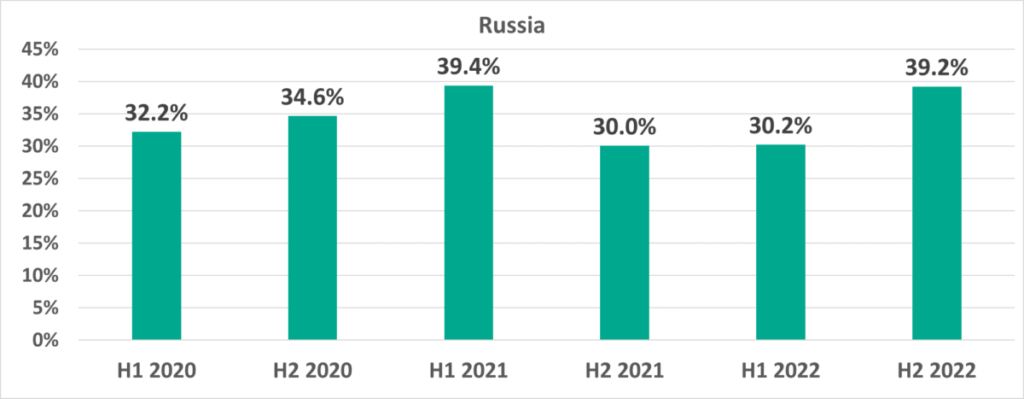
After rising and falling during H1 2022, monthly percentages of ICS computers on which malicious objects were blocked increased during the first three months of H2 2022. It is worth noting that the month-by-month dynamics of these figures in 2022 were completely different from those observed during the previous year, i.e., 2021.

January – December of 2021 and 2022
The increase in the percentage of ICS computers in Russia on which malicious objects were blocked in H2 2022 was due to a sharp increase of 11.1 p.p. in the percentage of ICS computers on which malicious scripts and phishing pages were blocked.
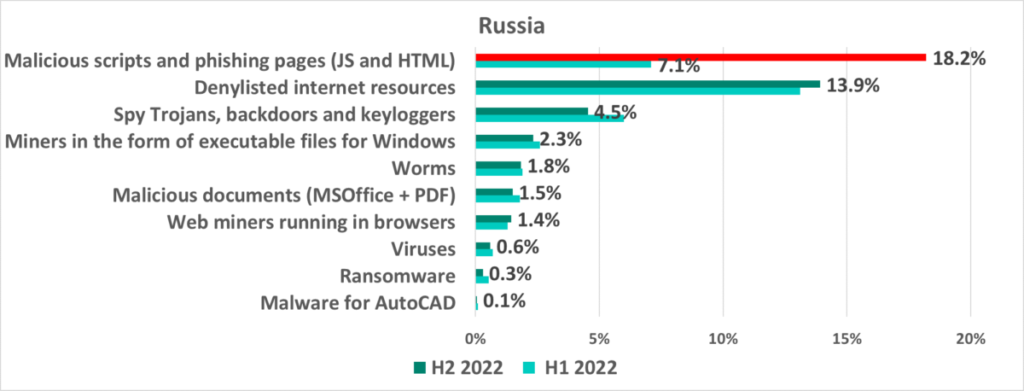

The sudden surge in the percentage of ICS computers on which malicious scripts and phishing pages were blocked in August and September 2022, as well as the high figures in the following months, were due to mass infections of websites (including those of industrial organizations) that use an outdated version of a popular Russian CMS. It should be noted that ICS computers from which arbitrary websites can be accessed are mostly ICS operator or engineering workstations.
A vulnerability discovered back in March 2022 enables an attacker to execute arbitrary code on the web server. In the process of carrying our mass infections of websites that were not updated in a timely manner, the attackers infected JavaScript files used on each site, injecting code that redirects browsers to third-party malicious web resources and phishing pages.
Apart from Russia, the distribution of malicious scripts resulting from the mass infections of un-updated websites managed by the CMS also affected ICS computers in Belarus and countries in Central Asia. In H2 2022, the percentage of ICS computers on which malicious scripts and phishing pages were blocked increased:
- in Belarus, by 10.3 p.p., yielding 17.8% in H2 2022;
- in Kyrgyzstan, by 16.4 p.p., yielding 26.4% in H2 2022;
- in Uzbekistan, by 7.8 p.p., yielding 15.6% in H2 2022;
- in Kazakhstan, by 6.1 p.p., yielding 14.1% in H2 2022.
As regards the increase (starting in April 2022) in the percentage of ICS computers on which attempts to access malicious web resources were blocked, it was largely due to a surge in the activity of potentially dangerous advertising platforms that are often used to spread malware disguised as advertising displayed on various web resources.
In H2 2022 Russia saw an increase of 12 p.p. in the percentage of ICS computers on which internet threats were blocked.

In H2 2022 in Russia, most industries saw an increase (in some cases, quite significant) in the percentage of ICS computers on which malicious objects were blocked – both as a consequence of mass distribution of malicious scripts and due to a relatively small increase in the percentage of ICS computers in Russia on which spyware was blocked.
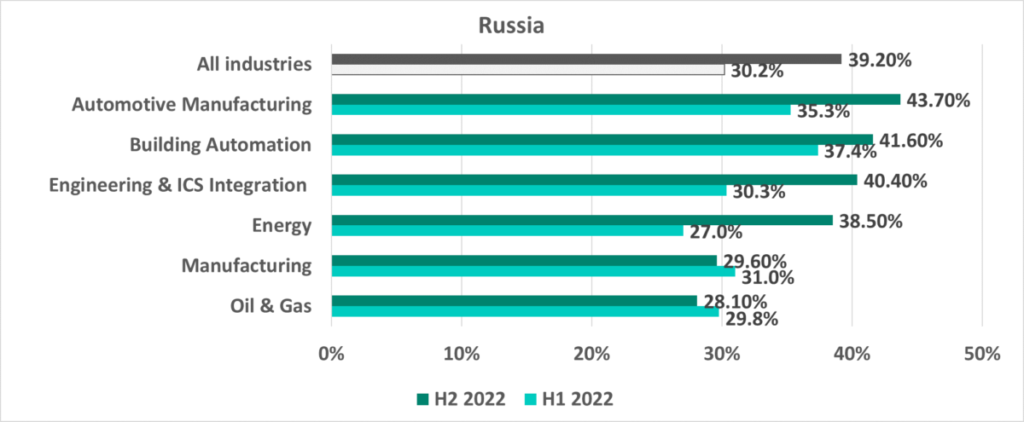
The decrease in percentage compared to H1 2022 in the manufacturing and oil and gas industries was due to the lower figures recorded for internet and email threats.
Global threat statistics
In 2022, the overall percentage of ICS computers on which malicious objects were blocked was 40.6%. As in 2021, the percentage increased, compared to the previous year, by 1 p.p.

However, while in H1 2022 the percentage of ICS computers on which malicious objects were blocked increased only by 0.4 p.p. compared to the previous six-month period, in H2 2022 the percentage increased by 3.5 percentage points, reaching 34.3%. This was higher than the percentages for 2021 and even 2020, albeit not by much.

It can be seen in the diagram below that in 2022, the smallest percentage of ICS computers on which malicious objects were blocked was observed in Q1 and the main growth was observed in Q2. The percentages were the same in Q3 and Q4.

June, September and December were the ‘hottest’ months. The lowest percentage values were observed in March and October.

January – December 2022
In different regions of the world, the percentage of ICS computers on which malicious activity was prevented ranged from 40.1% in Africa and Central Asia, which led the ranking, to 14.2% and 14.3%, respectively, in Western and Northern Europe, which were the most secure regions.

The situation in different countries can vary greatly – even within the same region. For example, in most countries of the Middle East the percentage of ICS computers on which malicious objects were blocked in H2 2022 was within the range from 30% to 40%. However, the percentage in Yemen was 45.7% and, at the same time, the percentage in Israel was 12.1%. As a result, Yemen was among the ten countries and territories with the highest percentage and Israel – among the ten countries and territories with the lowest percentage.

African and Central Asian countries were prevalent among the 15 countries and territories with the highest percentage of ICS computers on which malicious objects were blocked in H2 2022. In the Top 10 countries with the lowest percentage, all countries, with the exception of Israel, were European.

In H2 2022, the greatest increase in the percentage of ICS computers on which malicious objects were blocked was observed in Russia (+9 p.p.) and Belarus (+6.9 p.p).
We noticed certain similarities in the monthly dynamics of the percentage of ICS computers on which malicious objects were blocked in these two countries. Kazakhstan was another country with similar dynamics.
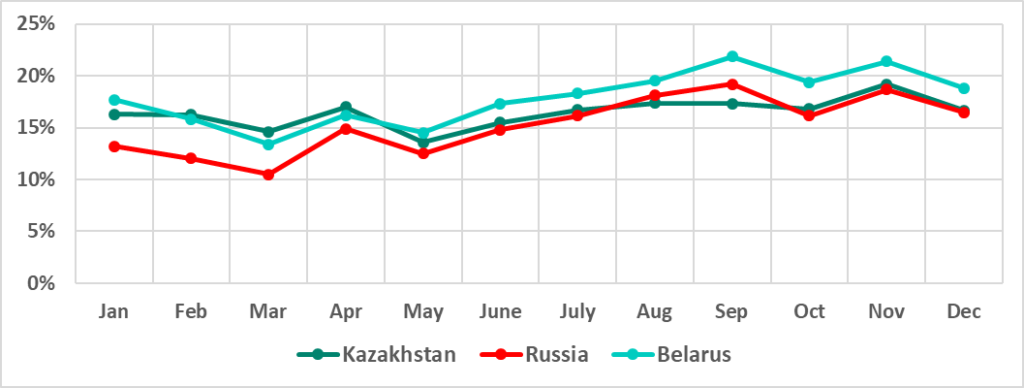
The situation was also different in different industries. It can be seen in the diagram below that in H2 2022 the percentage of ICS computers on which malicious objects were blocked increased in the automotive industry (+4.6 p.p.) and in the energy sector (+1 p.p.). In other industries tracked, the percentage decreased.
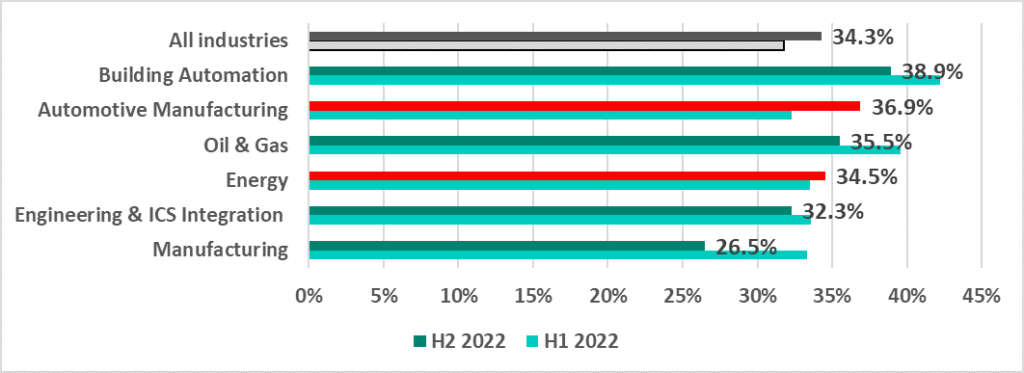
Variety of the malware detected
In H2 2022, Kaspersky security solutions blocked malware from 7,684 different families on industrial automation systems.
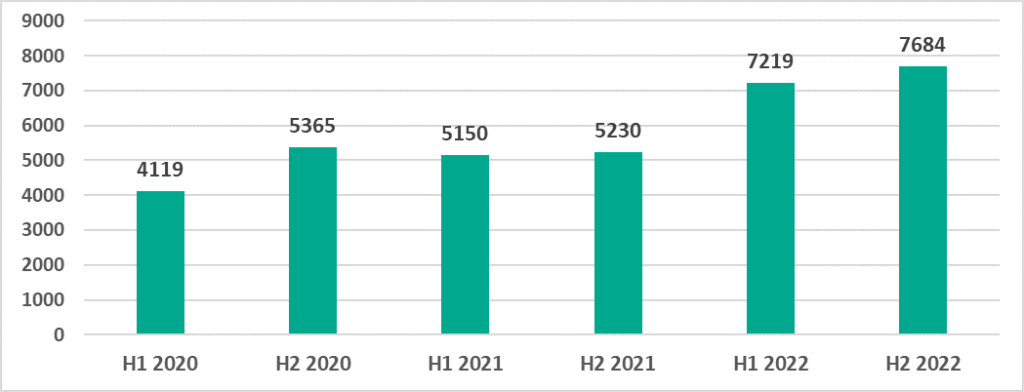
Malware categories
Malicious objects blocked by Kaspersky products on ICS computers fall into many categories. You can find a brief description of each category in a separate document.
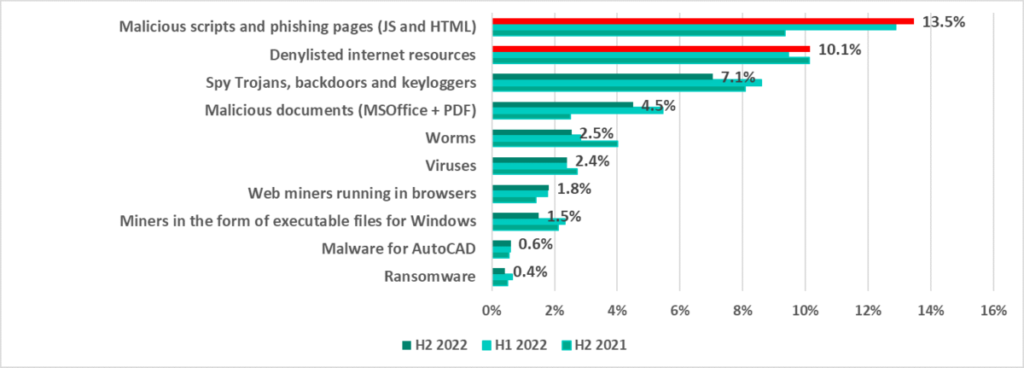
*Note that the resulting percentages should not be summed up because in many cases threats of two or more types may have been blocked on a single computer during the given reporting period.
In H1 2022, we noted an increase in the percentage of ICS computers on which the malicious activity of several malicious object categories had been prevented. In H2 2022, the percentage increased only for the two categories that led the ranking. These were malicious scripts and phishing pages (JS and HTML) and denylisted internet resources. In H2 2022, the percentage figures for other categories of malicious objects either decreased or remained unchanged.
Malicious scripts and phishing pages (JS and HTML) and denylisted internet resources
Malicious scripts and phishing pages (JS and HTML) are distributed both online and via email. A significant part of denylisted internet resources are used to distribute malicious scripts and phishing pages.
Threat actors use malicious scripts for a broad range of tasks – from collecting information, tracking activity and redirecting browser requests to malicious web resources, to downloading various malicious programs or loading malware (e.g., spyware or tools for covert cryptocurrency mining) in the user’s browser.
In 2022, malicious scripts and phishing pages climbed to the top of the ranking, pushing down the leader of many years, denylisted internet resources.
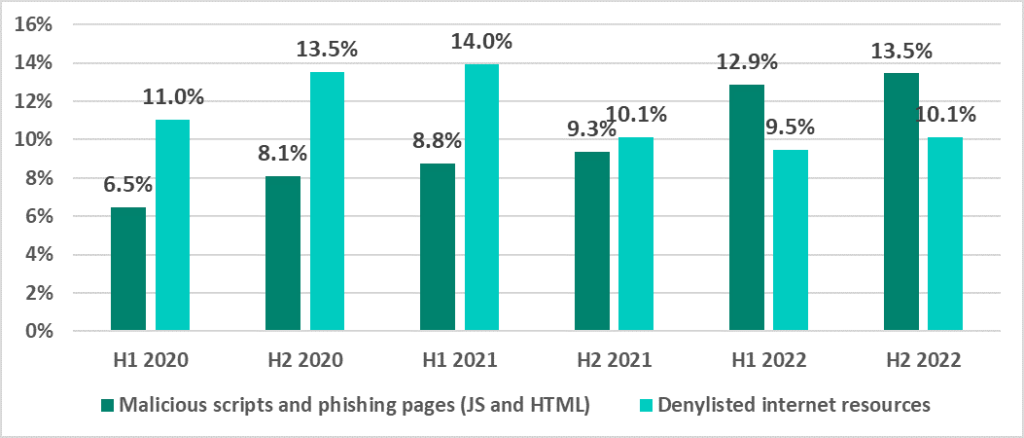
The increase in the activity of threats in these two categories clearly made a major contribution to the increase, in H2 2022, of the percentage of ICS computers on which threats coming from the internet were blocked (see below).
Among regions of the world, the highest percentages of ICS computers on which denylisted internet resources were blocked were observed in Central Asia and in Russia (15.2% and 13.9%, respectively). It is no surprise that these regions led the ranking based on the percentage of ICS computers on which internet threats were blocked.
The same regions were also the largest contributors to the increase in the percentage of ICS computers on which malicious scripts and phishing pages were blocked. This was due to above-mentioned mass infections of websites (including those of industrial organizations) that use an un-updated and outdated CMS version.
Russia was the region where the highest percentage among all regions (18.2%) and the most significant increase (+11 p.p. compared to H1 2022) were observed. Central Asia was in fourth place among regions based on the former parameter (14.2%), but the region also saw a significant increase in that parameter
in H2 2022 (+5.7 p.p.).
In other regions of the world, the percentage of ICS computers on which malicious scripts and phishing pages were blocked did not increase.
Spyware
The percentage of ICS computers on which spyware was blocked decreased by 1.5 p.p. This percentage had been growing during the period from 2020 through H1 2022.
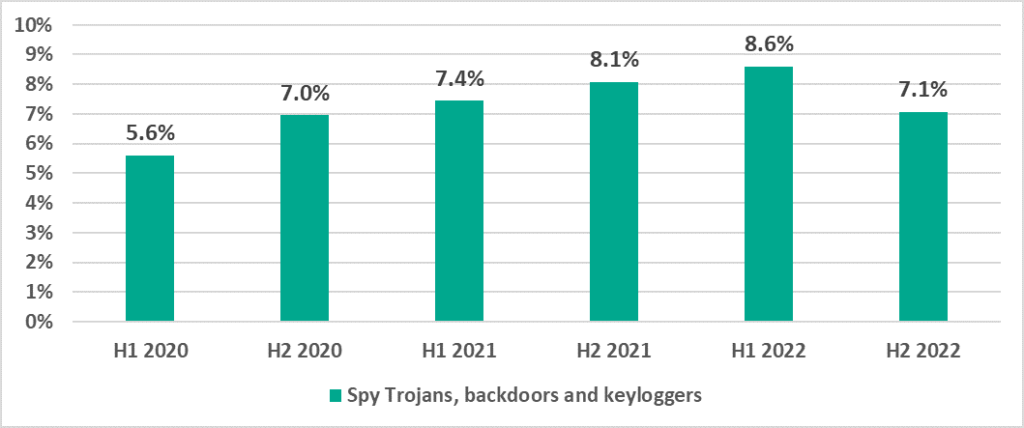
It is worth noting that in H2 2022 in Africa the percentage of ICS computers on which spyware was blocked was 12%, which was the highest figure for any region of the world. The figures were also high in South-East Asia (10%) and the Middle East (9.8%).
Among countries and territories, this percentage was the highest in Yemen (22.3%), Algeria (18.3%), Sri Lanka (18.3%), and Serbia (17.2%).
Malicious documents (MSOffice+PDF)
The percentage of ICS computers on which malicious documents (MSOffice + PDF) were blocked also decreased – by 1 p.p., from 5.5% to 4.5%. Threat actors distributed malicious documents via phishing emails and used them in attacks designed to achieve initial infections of target computers.
Among regions of the world, the highest percentage of ICS computers on which malicious documents were blocked was observed in Southern Europe (6.9%) and Latin America (6.9%). These same regions also had the highest percentage of ICS computers on which email threats were blocked.
Malicious cryptocurrency miners
The percentage of ICS computers on which malicious cryptocurrency miners implemented as Windows executable files were blocked decreased by 0.8 p.p. The figures for web miners remained at the same level as in H1 2022.
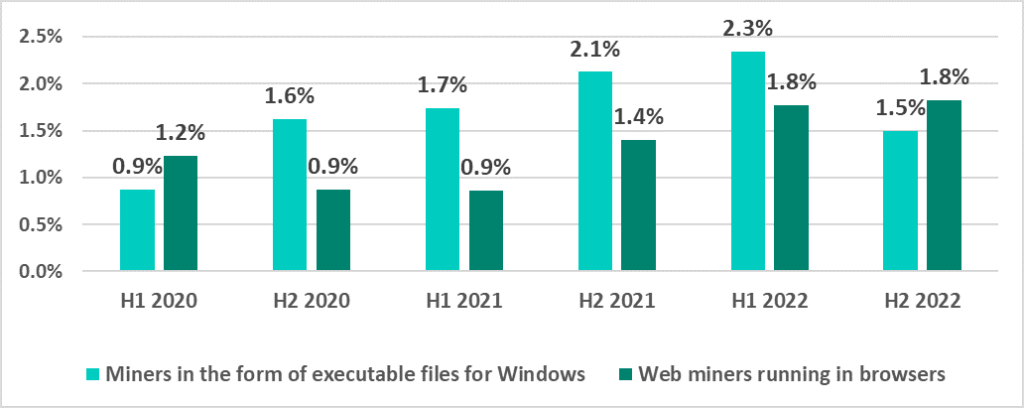
Cryptocurrency miners are often distributed via websites to which users have been redirected by malicious scripts. These are hosted by threat actors on media resources and sites providing pirated content.
In H2 2022, regions with the highest percentage of ICS computers on which cryptocurrency miners were blocked were: Central Asia (miners implemented as Windows executable files, 3.8%) and Africa (web miners, 3.4%).
The three countries with the highest percentage of web miners blocked were Yemen (9.3%), Egypt (7.8%) and, unexpectedly, a European country, Serbia (7.5%).
Viruses and worms
The percentage of ICS computers on which viruses and worms were blocked continued to decrease. We believe this indirectly reflected systematic work related to deploying security solutions in OT environments, which helps eliminate pockets of infection and prevent self-propagating malware from spreading.

Viruses and worms are distributed on ICS networks via removable devices, network folders, infected files (including backups) and network attacks on outdated software, such as Radmin2.
The decrease in the percentage of ICS computers on which such malware was blocked was due, among other things, to more careful scanning of removable devices.
At the same time, the percentage of ICS computers on which worms were detected remained very high in Africa (7.1%), which, as a result, topped the ranking of regions based on the percentage of ICS computers on which threats were blocked when connecting removable devices. Viruses, on the other hand, remained a relevant threat in South-East Asia (8.1%).
There is a number of relatively old viruses and worms which are still spreading, although their command-and-control servers have long been shut down. In addition to undermining the security of infected systems, e.g., by opening network ports and changing settings, these older worms and viruses can potentially cause software crashes or denial-of-service conditions.
New versions of worms are also sometimes found on ICS networks. Threat actors use these worms to spread spyware, ransomware and malicious miners in target networks. In most cases, these worms spread by exploiting vulnerabilities in network services (such as SMB and RDP) that have been fixed by vendors but are still unpatched in OT networks, using previously stolen authentication credentials or brute forcing passwords.
Malware for AutoCAD
Malware for AutoCAD, including viruses, was detected primarily in East Asia (3.1%) on computers that are part of OT networks, including network folders and engineering workstations.
The ranking of countries based on the percentage of ICS computers on which malware for AutoCAD was blocked was led by Ethiopia (5.8%), Sri Lanka (5.0%), and China (4.9%). Percentage figures for other countries ranged between 3.2% and 0.01%.
Ransomware
Ransomware was blocked in H2 2022 on 0.43% of ICS computers.
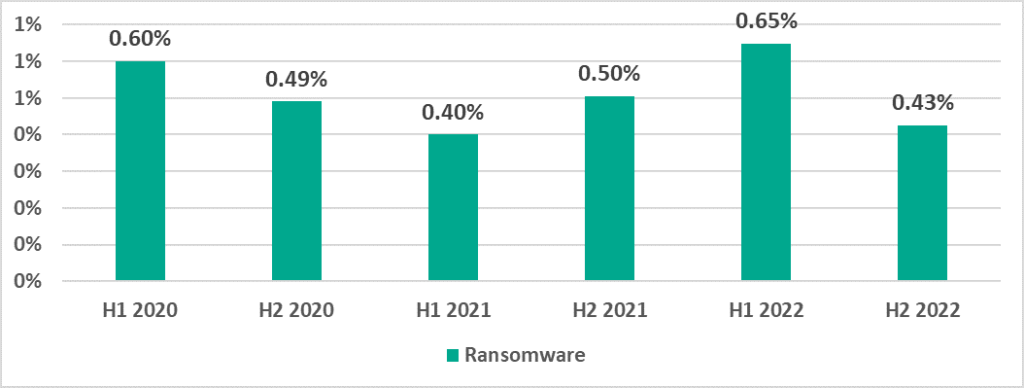
During all of 2022, the highest percentage of ICS computers on which ransomware was blocked was observed in February (0.27%), the lowest in November (0.10%).

In H2 2022, the percentage of ICS computers attacked by ransomware decreased in almost all regions. The only exception was Northern Europe, where a small increase (+0.03 p.p.) was observed.
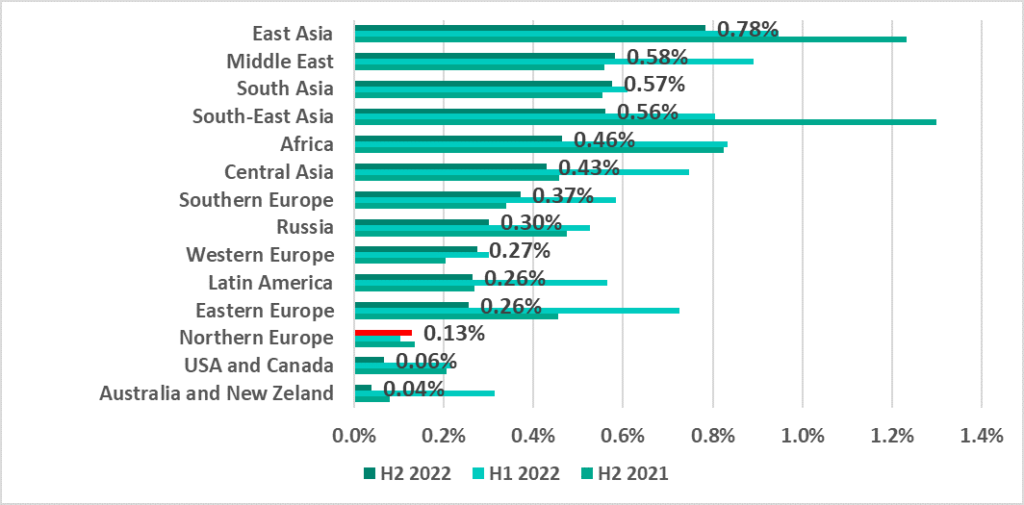
East Asia and the Middle East continued to lead the ranking, while Africa was pushed down from third place by South and South-East Asia.
In H2 2022, Yemen and Afghanistan led the TOP 15 ranking of countries and territories with the highest percentage of ICS computers on which ransomware was blocked. In Afghanistan, the percentage increased in H2 2022 by 3.22 p.p., which was the greatest increase for any country.
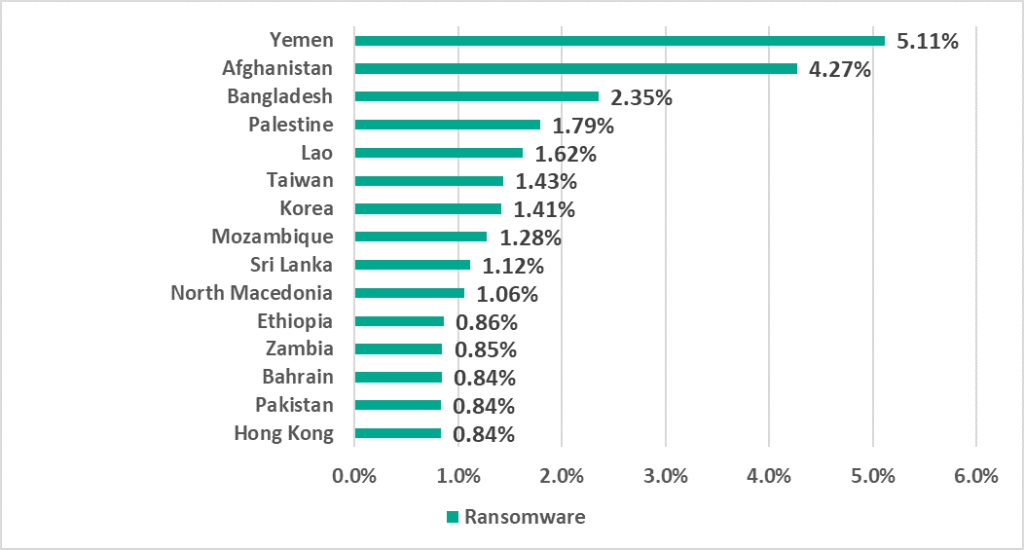
Note that in H2 2022, the ranking included one European country, North Macedonia.
Main threat sources
The internet, removable devices and email clients remained the main sources of threats for computers in the operational technology infrastructure of organizations. It should be noted that, in some cases, the sources of blocked threats could not be reliably identified.
World

The percentage of ICS computers on which internet threats were blocked increased from one quarter to the next throughout 2022. At the same time, the percentage of email threats peaked in Q2, with a noticeable increase in the percentage figures recorded in June.


There was also a noticeable increase in Q2 2022 in the percentage of ICS computers on which threats were blocked in network folders.

In H2 2022, threats whose source was network folders were blocked on 0.6% of ICS computers.
As with overall statistics on all threats, the percentage of ICS computers on which malicious objects from different sources were blocked varied according to country and region.
Regions and countries
Internet
In H2 2022, a very significant growth in the percentage of ICS computers on which internet threats were blocked – 12 p.p. and 7.8 p.p., respectively – was recorded in the regions Russia and Central Asia. As a result, these regions took top positions in the ranking based on this parameter, displacing traditional leaders – Africa, South-East Asia, and the Middle East.
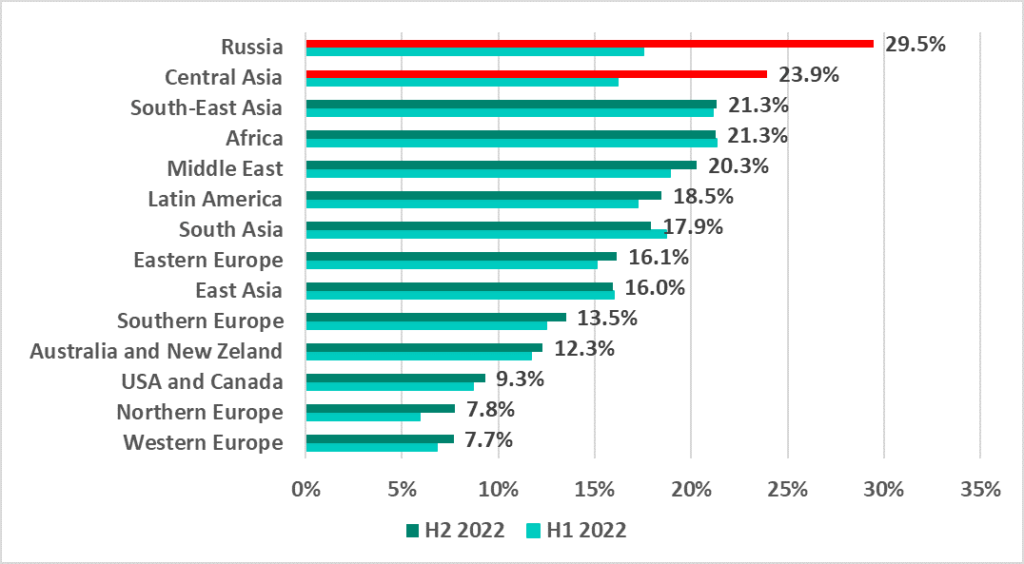
As a result of a sharp increase in the percentage of ICS computers on which internet threats were blocked in Russia, the country became one of the top three countries and territories based on this parameter.

It should be noted that such high positions in both rankings are not characteristic of Russia.
Removable devices
As per tradition, Africa topped the ranking of regions based on the percentage of ICS computers on which malware was blocked when removable devices were connected.

African countries were also prevalent in the ranking of 15 countries and territories with the highest percentage of ICS computers on which malware was blocked when removable devices were connected.

Email clients
Southern Europe, which, in H1 2022, topped the ranking of regions based on the percentage of ICS computers on which malicious email attachments and phishing links were blocked, remained at the top of the ranking in H2. Northern Europe was the only region in which the percentage increased in H2 2022, albeit insignificantly (+0.3 p.p.).

The list of 15 countries and territories with the highest percentage of ICS computers on which email attachments and phishing links were blocked included countries located in Southern Europe, as well as other regions.

We recommend that security experts in these countries make a special emphasis on protecting enterprise employees from phishing emails.
Network folders
Network folders was a minor source of malicious objects. The highest percentage of ICS computers on which threats were blocked in network folders was seen in East, South-East and Central Asia.
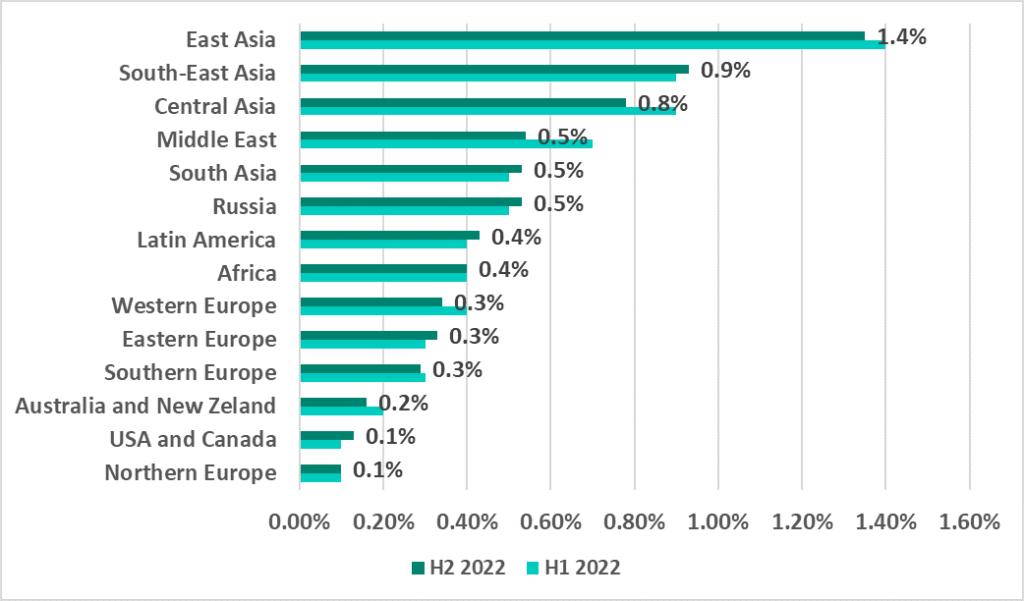
Turkmenistan, mainland China and Bangladesh led the Top 15 ranking of countries and territories with the highest percentage of ICS computers on which malicious objects were blocked in network folders in H2 2022.

Methodology used to prepare statistics
This report is based on an analysis of statistical data collected through the Kaspersky Security Network (KSN), a distributed antivirus network. The data was received from those KSN users who have given their voluntary consent to have data anonymously transferred from their computers and processed for the purpose described in the KSN Agreement for the Kaspersky product installed on their computer.
Connecting to the KSN provides an opportunity for our clients to improve the reaction speed of our security solution to new and unknown threats. It also improves the detection quality of the solution due to the access to the cloud infrastructure where data on malicious objects is stored. This data is only accessible via the cloud due to the size of the database and the resources required to store it locally.
The information transferred by the user includes only the types and categories of data described in the relevant KSN Agreement. This information not only assists in analyzing the threat landscape, but is also needed to detect new threats, including targeted attacks and APTs.[1].
The statistical data presented in the report was received from ICS computers protected by Kaspersky products that Kaspersky ICS CERT categorizes as part of the industrial infrastructure at organizations. This group includes Windows computers that perform one or several of the following functions:
- Supervisory control and data acquisition (SCADA) servers;
- Data storage servers (Historian);
- Data gateways (OPC);
- Stationary workstations of engineers and operators;
- Mobile workstations of engineers and operators;
- Human Machine Interface (HMI);
- Computers used for industrial network administration;
- Computers used to develop software for industrial automation.
For the purposes of this report, “attacked computers” are those on which Kaspersky security solutions blocked one or more threats during the reporting period (in the diagrams above, a reporting period can be a month, a six-month period or a year, depending on the context). When determining the percentages of machines on which malware infections were prevented, we use the ratio of the number of computers attacked during the reporting period to the total number of computers in our sample from which we received depersonalized information during the reporting period.
[1] We recommend that organizations that have any restrictions in place with respect to transferring data outside the organization’s perimeter consider using the Kaspersky Private Security Network service.
